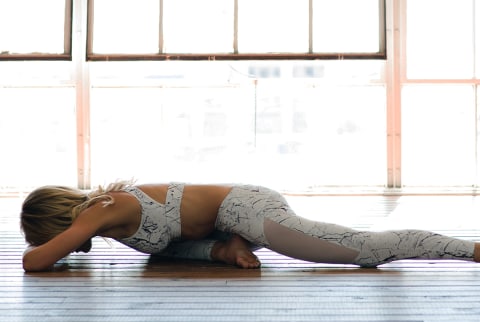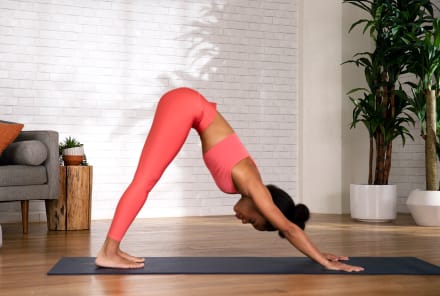Advertisement
How To Do Pigeon Pose & Why It's Perfect For Your Bedtime Routine


Few yoga poses are as juicy and relaxing as pigeon pose. There's something so satisfying about stretching the hips, allowing your body to melt into the floor, then staying there for a few minutes.
And according to integrative psychiatrist and sleep specialist Nishi Bhopal, M.D., pigeon pose is also a great option for a pre-bedtime stretch. Here's how to do it right, plus tips, modifications, and benefits.
How to do pigeon pose, eka pada rajakapotasana:
- Begin in tabletop, on your hands and knees.
- Bring your right knee toward the right outer edge of your mat, rotating your hip out and dropping your shin to the floor.
- Straighten out your left leg behind you so it's in line with your hip.
- Square your hips to the front of the mat.
- With your fingertips on the floor or your hips, lengthen out the spine by shining your chest upward and squeezing the shoulder blades back and down.
- With your spine lengthened, slowly lower your upper body down to your forearms.
- From there, extend the arms straight out in front of you and lower all the way down, resting your forehead on the mat.
- Hold for at least 2 minutes, breathing deeply.
- Walk your hands back to your hips and switch sides.
Tips & modifications:
- If you have a hard time lowering your hips to the ground in Step 4, you can place a block, bolster, or folded blanket under your hip.
- If lowering all the way down to the mat in Step 7 isn't accessible to you, try resting your head on a block.
- Backbends like cobra and bridge pose and hip openers like lizard and triangle pose can help you prepare for pigeon.
- Avoid pigeon if you're dealing with an ankle, knee, and/or hip injury.
- If pigeon is out of reach for you right now, try a figure-four stretch on your back.
What are the benefits?
"Opening up and stretching the hips is a great way to relax your muscles before bedtime," says Bhopal. "Asanas like pigeon pose help to lengthen the hip flexor, reduce stiffness in the body, and alleviate pain in the lower back."
This eases not only physical tension but mental tension as well—which is just what you need before bed. And even though it's a very relaxing pose, you're still working your quads, hip flexors, psoas, chest, and shoulders. So, if you sit at a desk for a lot of the day, this is a great pose for you. And not for nothing, research shows a regular yoga practice can reduce symptoms of insomnia and improve overall sleep quality1, Bhopal notes.
This is one pose you'll definitely want to incorporate into your next flow if your hips need a little TLC, and of course, right before you go to bed. With your body relaxed, hips stretched, and mind calm, you'll be snoozing in no time.











